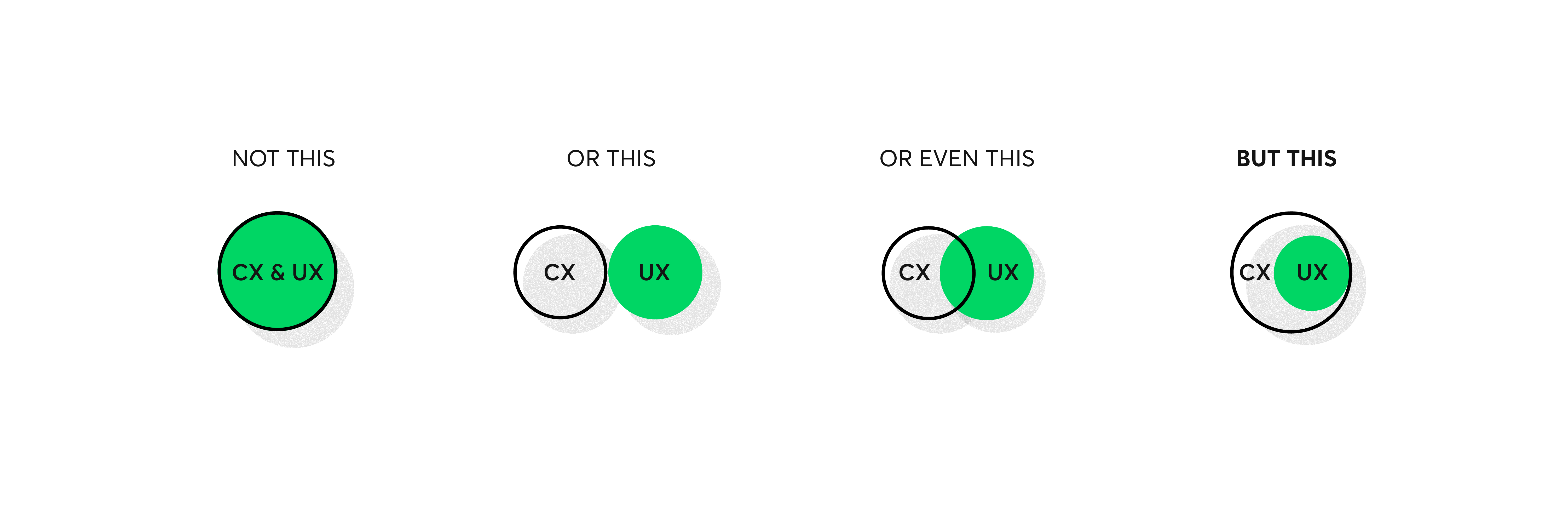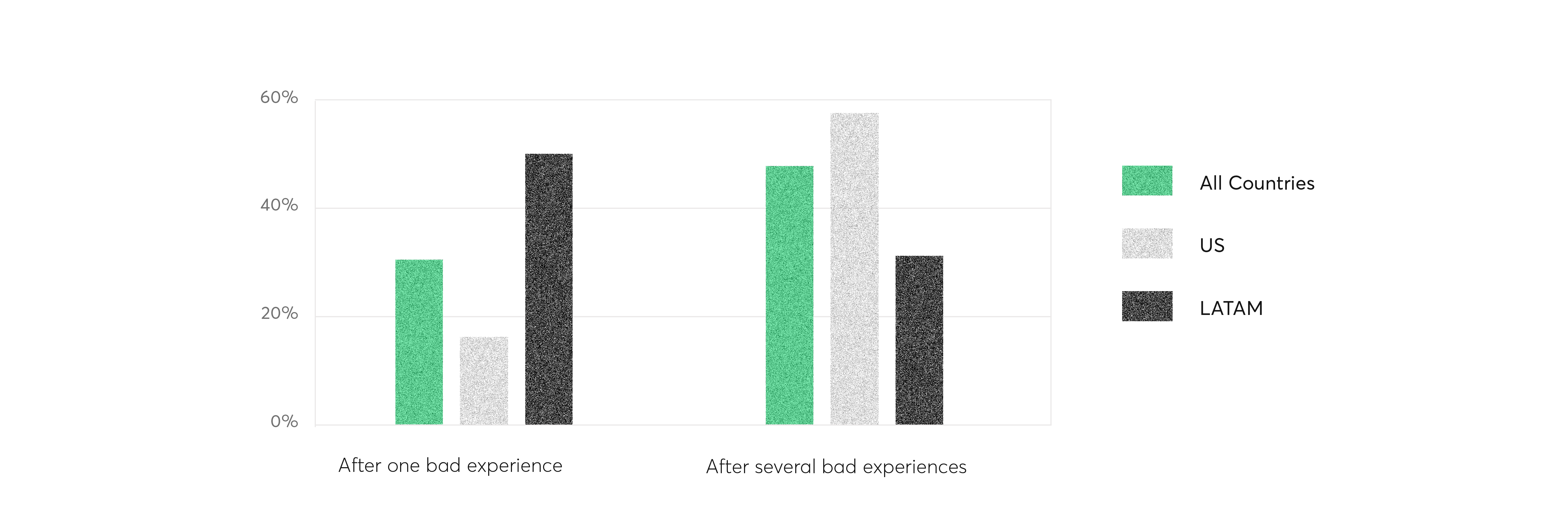Customer Experience vs. User Experience – What's The Difference?

Story co-authored by Diana Woch, Senior UX Designer at Netguru.
The confusion comes from how we tend to define our clientele. Our users are our customers – so the user experience and customer experience must be equivalent, right?
Actually, no. UX and CX are two different concepts, and it’s essential to understand this distinction if your users/customers are to enjoy the best possible overall experience of your product and your brand.
So let’s clear things up.
What Is User Experience?
The concept of user experience is specific to your digital product, i.e., person's experience with your app, software, or website. UX applies to the experience that a user/customer has when they interact with that product.
The design of your product and its interface – its usability,navigation, visual hierarchy, information architecture, etc. – combine to create a user experience that is either positive or negative for the product’s users. Thus, UX isn't just about creating an intuitive interface and visually appealing designs; it's about understanding and addressing the users’ entire customer journeys.
Accordingly, UX design is the process of designing products that are intuitive, easy to navigate, and enjoyable to use.
How to measure user experience
Measuring a user's experience can be challenging as it is subjective and influenced by many factors. However, several methods can help to measure UX.
One way is to use analytictools that provide quantitative data on how the product is performing and how users interact with it. Some key cx metrics include:
- Success rate: The percentage of users who complete a goal within your product or reach a stage you want them to reach.
- Error rate: The number of mistakes a user makes when completing a specific task.
- Task time: The amount of time it takes a user to complete a task.
- Clicks to completion: The number of clicks the user performs before completing a task.
- Abandonment rate: The percentage of users who abandon the task before finishing it.
Another way to measure the UX experience is by using quantitative methodologies:
- Surveys: This is one of the most common methods to measure user experience. Surveys can help you understand user satisfaction, identify pain points, and gather feedback on specific features or aspects of your product.
- Heatmaps: They can provide a visual representation of where users click or scroll on a page, which can help identify patterns and areas of interest or frustration.
- A/B Testing: This method involves creating two versions of a product or feature and testing them with different groups of users to see which performs better. This can help identify which design or functionality options are more effective.
- Net Promoter Score (NPS): A survey-based metric that measures how likely users are to recommend your product to others. It can provide insight into overall user satisfaction and loyalty.
What Is Customer Experience?
Customer experience, on the other hand, is a much broader concept. It’s the relationship level and experience that a user/customer has whenever they interact with your brand – not just your digital product.
Your app, software, or website is not the totality of your brand and, therefore, not the totality of the customer experience. CX interactions occur across multiple devices and at multiple touchpoints throughout, including advertising, social media channels, marketing materials, sales process, pricing, customer service and support, and your actual product.
As such, customer experience is something of an umbrella term encompassing all channels and touchpoints. It is the customers’ perceptions of the organization and its services as a whole, not just the usability and functionality of its digital products.
How to measure customer experience
CX is measured with metrics that take into account the “big picture.” These are, among others:
- Overall satisfaction: How satisfied your customers are with their interactions with your company, its services, and products.
- Net Promoter Score (NPS): The willingness of customers to recommend your company and its product(s) to others.
- Loyalty: The likelihood that customers will continue using your product vs. a competitor’s.
Customer experience vs. user experience – comparison table
|
Aspect |
User Experience (UX) |
Customer Experience (CX) |
|
Scope |
Interaction with a specific product, system, or service. |
The entire journey with a brand, covering all touchpoints. |
|
Focus |
Usability and functionality of a product/interface. |
Overall perception across all customer interactions with a company. |
|
Measurement |
E.g. A/B testing, heat maps, usability studies, feedback. |
E.g. Surveys, Net Promoter Score, customer satisfaction scores. |
|
Outcome |
Increased user satisfaction, engagement, and reduced friction. |
Enhanced brand loyalty, enhanced brand loyalty, increased customer retention, and positive word of mouth. |
|
Responsibility |
UX Designers, UI designers, developers, product managers. |
UX Designers, sales specialists, marketing specialists, customer support, and more. |
|
Examples |
Intuitive app design, pleasant interface, bug-free experience. |
Quality products, exceptional service, enjoyable in-store experience. |
The Importance of Good UX and Good CX

As you have surely deduced by this point, UX is a subset of CX. User experience is the experience your customers have with your product, whereas customer experience is the experience they have with your brand as a whole.
Both UX and CX are important to get right. Nowadays, customer experience is the top brand differentiator, and user experience – whether good or bad – is a highly influential element of the overall CX.
According to PwC’s 2018 “Future of Customer Experience” study, nearly one-third (32%) of consumers said they would walk away from a brand they love after one single bad experience and 59% after several bad experiences. In addition, the study also found that customers are willing to pay as much as 16% more for a better experience.

Image source: PWC
Customer satisfaction: The importance of good UX
The essence of good UX lies in understanding and optimizing how users interact with a product or system.High-quality UX design is important because users will decide within just a few seconds whether your app, software, or website is worth their time – i.e. whether it is easy to use, functional, enjoyable, easy to navigate, and solves their problem – and whether or not they will be coming back for more. UX can significantly enhance user satisfaction, increase engagement, and foster loyalty.
The primary goals of UX include making interfaces intuitive and user-friendly, reducing friction and barriers that users might face, and ensuring seamless and enjoyable interactions. When users find a product easy to use, they're more likely to continue using it, recommend it to others, and form a positive perception of the associated brand.
Customer satisfaction: The importance of good CX
Good CX goes beyond the usability and functionality of your product. You cannot underestimate its importance: it serves as a key differentiator in a competitive market where consumers have a multitude of products to choose from.
Strong CX strategy plays a crucial role in improving a brand's reputation, and positively influencing customer loyalty and customer lifetime value (what the customer spends for the products over their entire relationship with the brand). The central goals of effective CX are to consistently meet expectations, build lasting relationships, and foster positive customer feedback. By offering reliable service, addressing customer issues in a timely manner, and ensuring satisfaction, businesses aim to retain and grow their customer base.
In today's environment, where consumers have numerous choices and avenues to share their views, maintaining a positive CX is essential for brand success.
The interplay of UX and CX
Understanding the relationship between User Experience (UX) and Customer Experience (CX) is essential for any business striving for cohesive and positive customer interactions. While it's possible to have good UX but poor CX, or vice versa, excelling in both is crucial. One effective strategy for achieving optimal UX is selecting the right agency to craft your user experience.
Let’s look at two hypothetical scenarios to illustrate possibile use cases.
What happens when you have good UX and bad CX?
Let’s say John visited an online store to buy a new phone. The website had great UX and UI.The search engine was accurate and powerful, and the product comparison tool allowed him to put his potential purchases against each other easily, drawing on readily accessible product reviews from other customers. Using this well-designed site, John quickly found the right phone. The checkout process was also seamless, multiple shipping options were available, and within just a few clicks, John completed the purchase and his new phone was on its way.
However, when he received the package, he realized that the phone inside wasn’t the one he’d ordered. He immediately called customer support but was placed on hold for a long time. When an agent eventually took his call, they couldn’t trace his order number, and told John that someone would call him back within an hour. Two days passed without a call. When John finally received the call back, he was told he must first send the phone back at his own expense before the company would send him the correct one. The whole process took nearly two weeks.
Conclusion: Even though the UX of the ecommerce site was exemplary, John’s experience after placing his order was nothing short of disastrous. He poured his grievances into a negative review and, likely, will completely forget how good the UX was because the overall CX was so poor.
What happens when you have good CX and bad UX?
Now let’s consider the flipside of the coin – when the CX is good but is let down by bad UX.
The next time John wanted to buy a new phone, haunted by the bad experience with Company A, he decided to visit a different online store.
However, Company B’s ecommerce site was seriously lacking in usability and functionality. There was no search engine, no product comparison tool, and no customer review section. In the end, John only bought his phone there because he found a good price for the selected model.
But history repeated itself and Company B sent him the wrong phone too. However, when John called customer support, they were more than helpful and endeavored to solve his problem immediately. With no questions asked, they sent John the correct phone the very next day, and the courier took away the wrong phone – free of charge. What’s more, Company B gave John a 25% discount coupon to apply to his next purchase and apologized for the mistake.
Conclusion: Even though the UX of Company B’s site left a lot to be desired, and the shop made a mistake, the overall CX was positive and John is unlikely to leave a negative review.
Conclusion
It’s important to note that Company B only had a chance to redeem themselves with good CX after they made a mistake. If the company had sent the right phone in the first place, John would have likely remained dissatisfied with his experience because the UX was so bad. Bad UX will often lead to bad CX and loss of customers.
A brand may have the best advertising, social media presence, sales team, customer service, and returns policy in the world – but if customers don’t have a good experience with its website, app, or software, the overall impression fails.
That’s why a human-centric approach in CX is essential. Understanding and prioritizing the human element can make all the difference in how customers perceive their interactions with your brand.
Consistently positive customer experiences can foster customer loyalty, making them more likely to return and recommend the brand to others. But failures in either area lead to a bad customer experience. Your company must continuously optimize both if you are to remain competitiveand delight your users/customers across every touchpoint.



